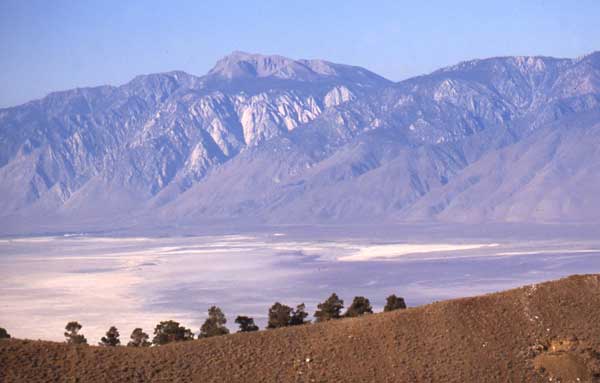^ View of Owens Lake from the Inyo Mountains, looking westward to the Sierra Nevada.
Threat to Unique Wetland Restoration
Inyo County, California south of the town of Lone Pine - By Laura Cunningham
I used to work here back in the early 1990s when I was a seasonal for California Department of Fish and Game. Owens Lake was, and still is, a huge white playa with oases of springs and wetlands dotting its edges. The Owens River once flowed into the lake on the north end before its waters were sucked into giant pipes for shipment south to Los Angeles, a controversial project that happened in 1913.
But lately a new threat to this wild area has arisen. Los Angeles Department of Water and Power (LADWP, or 'DWP') wants to try to get out of its water woes by building a 600 plus-acre solar energy pilot project on the dry lake bed. Apparently they want to avoid doing an environmental impact analysis. The photovoltaic panels would generate 50 MW by 2012, and the plant would cost an estimated $1.7 million annually to operate. This would be a possible precursor to a much larger solar farm that could cover thousands of acres, 400 MW by 2014.
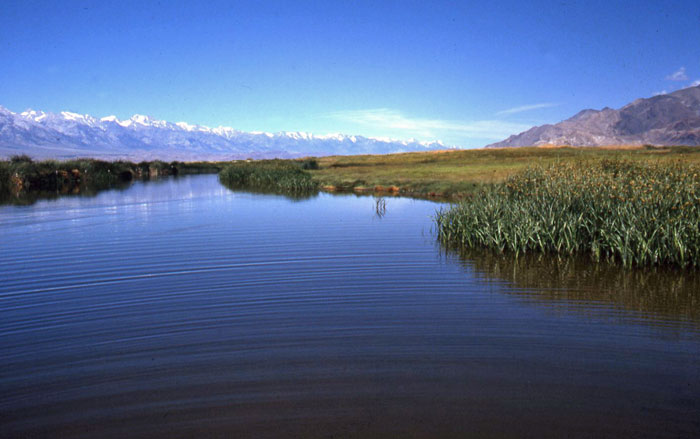
^Beautiful spring-fed pool in the early 1990s at the edge of Owens Lake. The Sierra Nevada and Inyo Mountains frame the picture.
Great Basin Unified Air Pollution Control District is requiring DWP to raise its 68,000 acre-feet per year of watering for dust control (since 1998), to 95,000 afy by April 1, 2010, watering an additional 9.2 square miles of lakebed. This will reduce the LA aqueduct diversions that flow water to the city, so DWP seems to be seeking alternatives to its court-ordered promise to control dust on the playa.
To comply with federal clean air standards DWP must control the dust that has plagued the Owens Valley for decades. Its efforts are part of a $500-million dust mitigation plan. The solar project still must win approval from the California State Lands Commission. The DWP program includes flooding portions of the lake bed with water to help control dust.
Michael Webster, DWP assistant manager of system development and procurement, says they have tested solar arrays in wind tunnels and determined that the structures can work as effective dust control measures. DWP is looking at low fencing around the solar panel area and between rows of panels to help block the wind and dust. We are not so sure that sand-blasting is good for photovoltaic surfaces, however.
 David Freeman (right) headed LADWP when the lake dust control deal was done. Now he wants solar there. He toured representatives of the Public Utilities Commission and California Energy Commission at Owens Lake, touting how DWP could save 2,460 acre-feet of water a year -- worth $1.7 million -- because the solar arrays could be used to control dust in that portion of the dry playa instead of flooding.
David Freeman (right) headed LADWP when the lake dust control deal was done. Now he wants solar there. He toured representatives of the Public Utilities Commission and California Energy Commission at Owens Lake, touting how DWP could save 2,460 acre-feet of water a year -- worth $1.7 million -- because the solar arrays could be used to control dust in that portion of the dry playa instead of flooding.
Because the State Lands Commission has oversight of the 100-square-mile Owens Lake, DWP must convince that agency to lease the 616 acres for the pilot solar project.
But habitat restoration has been taking place for years already on the lakebed.
New interconnection to existing LADWP Cottonwood Substation, on 230 kV Inyo-Rinaldi line 6 miles to west, would occur.
LADWP is also considering solar projects east of the Owens River between Lone Pine and Independence. This is prime Tule elk habitat.
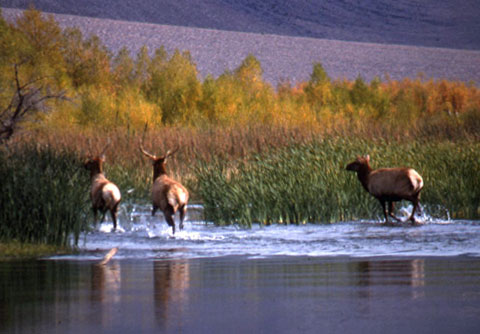
<Tule elk running across the lower Owens River just above Owens lake.
California State Lands Commission representatives met with DWP in mid December 2009, saying they were intrigued by the idea but remained wary because of DWP's history of using its political power to get its way and not cooperate with the state panel. Because of the Lands Commission's concerns about the size of the proposed pilot solar project, the array could be scaled back to about 80 acres.
As part of the proposed solar project, DWP says it would continue dust-control measures that involve flooding portions of the lake bed. Then a portion of Owens Lake could eventually become a state park, DWP told the commission.
We await the details of which type of photovoltaic design would be used, and members of BRW will re-visit Owens Lake to get updated photos soon.
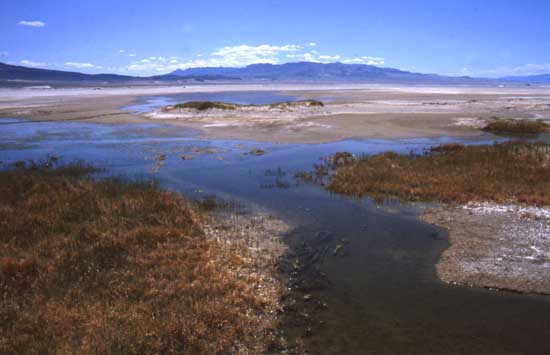
^Springs and wetlands near Keeler in 1992.
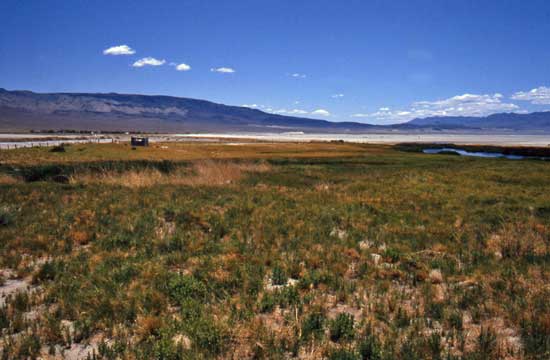
^Saltgrass meadow.

^Looking north across the dry playa up the Owens Valley. The Sierra lies on the left and the Inyo Mountains on the left.
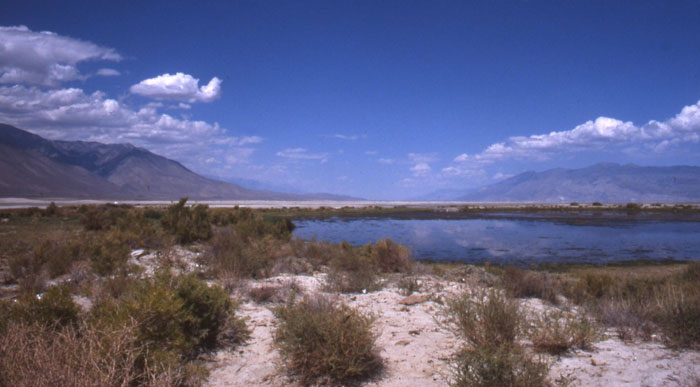
^Spring pool on the southeast side of the playa, 1992.
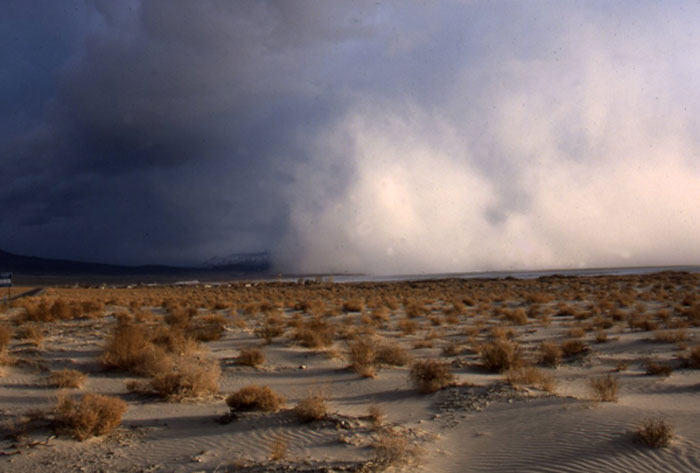
^Intense sand storm next to a dune system on the east side of the playa.

^We presume this transmission line is the one DWP wishes to hook its solar project into. Near Keeler. Note the dust blowing off the lakebed -- will this really be controlled by panels?
Spectacular Owens Valley
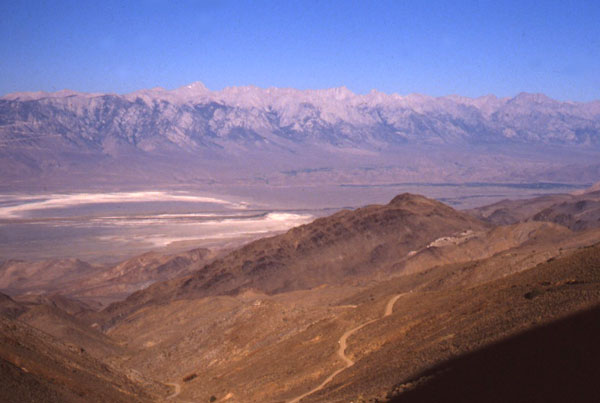
^The wall of the high Sierra rises above Owens Lake, as seen from the Inyo Mountains. 14,505 foot-high Mt Whitney overlooks to lake, the tallest summit in the contiguous United States.

^Mt. Whitney and full Moon, as seen from the Owens lake area.
Historically Owens Lake was one of the most important sites for migrating waterfowl and shorebirds in the western United States for thousands of years. Pioneering zoologist from the Joseph Grinnell from the Museum of Vertebrate Zoology at the University of California, Berkeley, during his Death Valley expedition, traveled to Owens Lake in 1917. He described abundant life in its waters: “ Great numbers of water birds are in sight along the lake shore -- avocets, phalaropes, ducks. Large flocks of shorebirds in flight over the water in the distance, wheeling about show in mass, now silvery now dark, against the gray-blue of the water. There must be literally thousands of birds within sight of this one spot. En route around the south end of Owens Lake to Olancha [I] saw water birds almost continuously.”
Los Angeles Department of Water and Power diverted the lower Owens River to the Los Angeles aqueduct in 1913. This drained most of the lake and turned it into a dustbowl. Starting in 1999 Memorandum DWP has been required to re-water portions of the playa to help the area meet federal air quality standards. Saltgrass meadows have been planted in an attempt to control dust, and other areas are flooded with shallow water (beginning in 2001). The Los Angeles Owens Lake Dust Control Project currently stretches across 30 of the Lake's 100 square miles.
And birds still come, thanks to these efforts and preservation of spring wetlands here. Owens Lake is a nationally significant Important Bird Area (IBA) as designated by the National Audubon Society. Thousands of shorebirds migrate through each fall and spring between the Arctic and Central and South America, and many thousands of snow geese and ducks winter at the lake. The endangered interior population of the Snowy plover nests on portions of the lake bed.
In April 2008 birders observed 112 species and a total of at least 46,650 birds in day. Such species as including California gulls, American avocets, Eared grebes, Black-bellied, Western and Least sandpipers, Wilson's and Red-necked phalaropes, Long-billed curlews, White-faced ibis, Black-necked stilts, Peregrine falcons, and Northern shovelers have been seen.
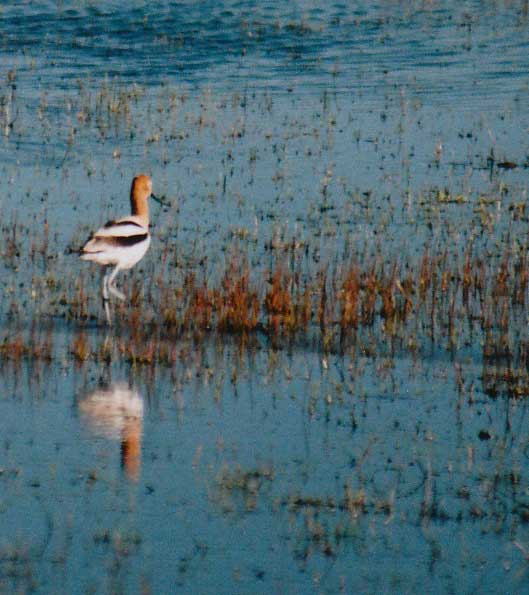
In fall 2008, the last phase of the dust control project began, to be completed in 2010. More than nine square miles of additional ponds and sheet flooding will be built. LADWP is also scheduled to complete a long-term habitat management plan for the entire dust control project. DWP is also investigating a method of dust control known as "moat and row" that uses no water.
>American avocet. (Photo taken in summer at Mono Lake).
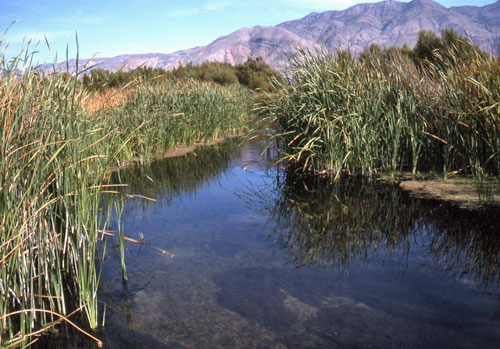
^Lower Owens River just before it is sucked into the L. A. Aqueduct above Owens Lake.
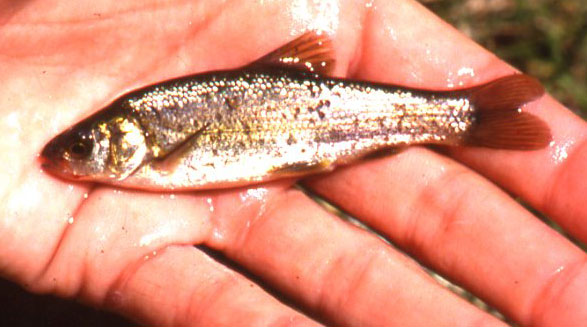
^Owens tui chub (Siphateles bicolor snyderi), young individual. These native fish were once thriving in the Owens River system.
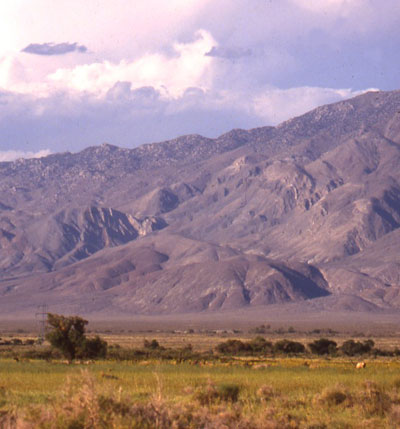
^Lush meadows and will-cottonwood groves of the Lower Owens Valley and the Inyo Range. Will this area too be made an industrial solar power plant for DWP?
More on Owens Lake from the Owens Valley Committee.
See stories in the Los Angeles Times >>here, and >>here; Inyo Register >>here, and Sierra Wave >>here.
HOME.....Sempra Photovoltaic Plant-Nevada.....Nextlight PV Plant Proposal-Nevada
